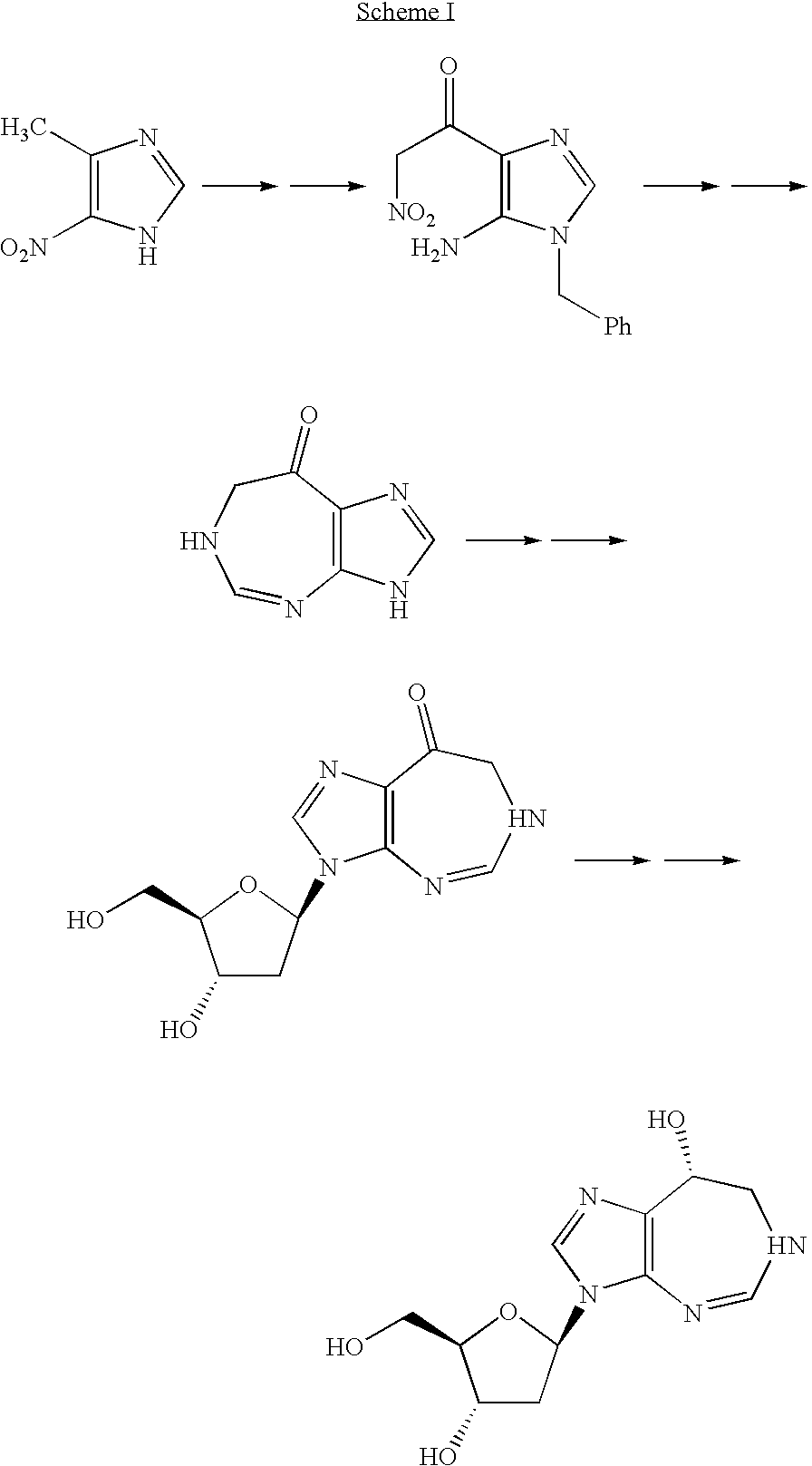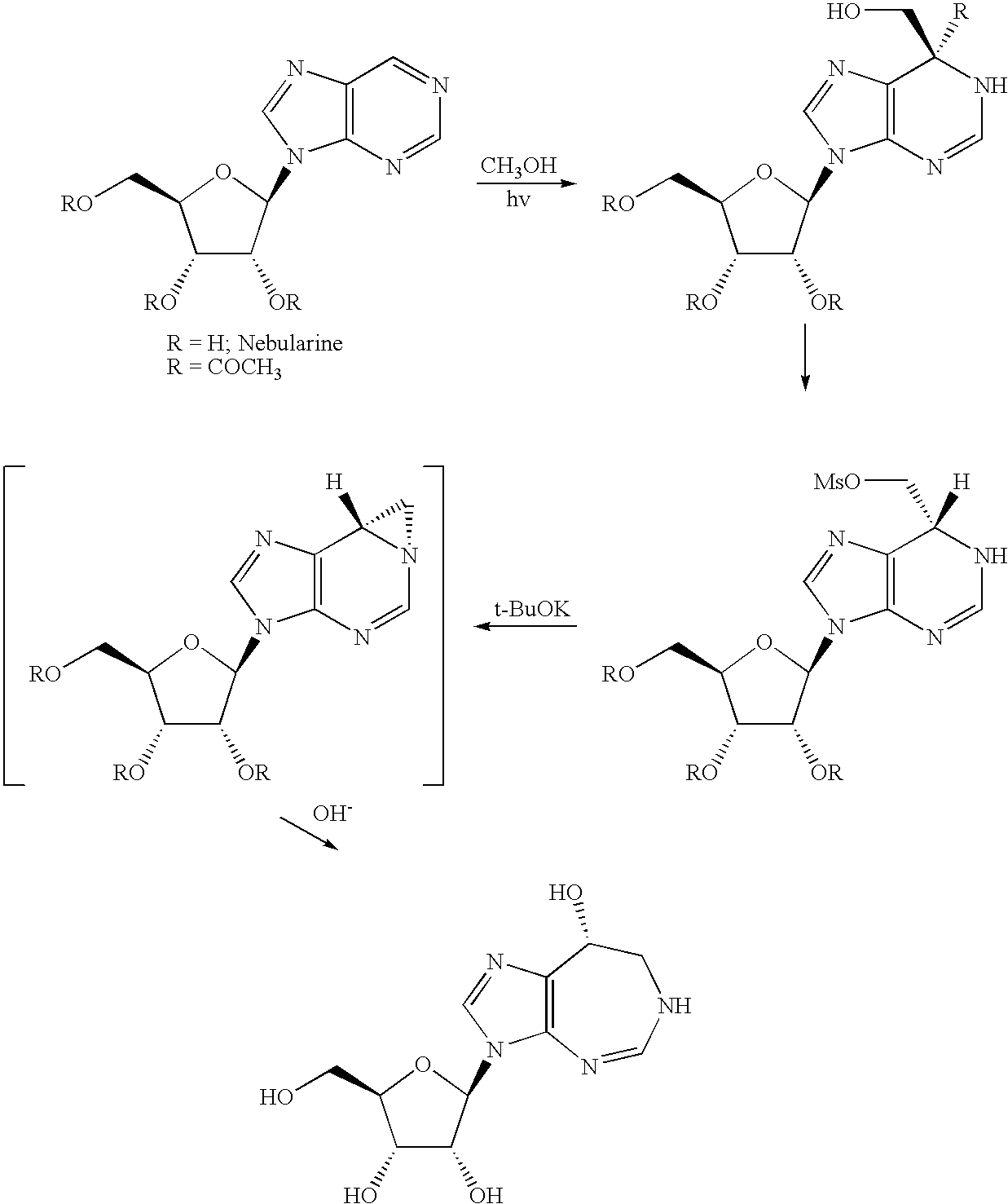Process for the production of pentostatin aglycone and pentostatin
a pentostatin and aglycone technology, applied in the field of pentostatin aglycone and pentostatin production, can solve the problems of low yield, no intermediate is commercially available, and protocol less desirable for large-scale production of pentostatin, and achieve the effect of reducing the cyano group of the substituted imidazol
- Summary
- Abstract
- Description
- Claims
- Application Information
AI Technical Summary
Benefits of technology
Problems solved by technology
Method used
Image
Examples
example 1
Diester-Epoxide 9 (Epoxidation)
[0065] Bromotartarate derivative 8 (12 g, 4 o mmol) was dissolved in 100 mL dry methanol and cooled down to 0.degree. C. A solution of NaOMe (3 g, 1.4 equiv) in 75 mL dry methanol was prepared and added drop-wise, in 2 h, to the methanolic solution of bromotartarate at 0.degree. C. After completion of addition the reaction mixture was allowed to stir at room temperature for 2 h. TLC (40% and 20% E-H) was used to monitor the reaction. Reaction was incomplete after 2 h. Additional 2 g NaOMe was added at room temperature. TLC showed more than 90% conversion to the higher R.sub.f spot. The excess NaOMe was quenched with acetic acid (10 mL). The reaction mixture was evaporated to dryness and the residue was extracted with CH.sub.2Cl.sub.2 / H.sub.2O. The organic layer was dried (Na.sub.2SO.sub.4) and charged on a silica gel column (Hexanes to 20% E-H).
[0066] Yield: 3 g of 9
[0067] This reaction was repeated on a 12 g scale and the yield was 4 g. Total yield: 7...
example 2
Diamide-Amine-Alcohol 10
[0068] Compound 9, the epoxide (FW 160.12, 7 g, 43.75 mmol) was dissolved in 100 mL methanol and 100 mL of sat. NH.sub.3 in MeOH: (.about.4M solution), .about.400 mmol (solubility is 1 g / 15 mL). The clear solution was heated in a Parr for 18 h at 70.degree. C. TLC analysis (20% AcOH--MeOH) showed complete conversion. The white precipitate was filtered off and dried in oven. Yield: 85% of 10.
[0069] This reaction was repeated 3.times.: 7 g, 7 g, 10 g. The yields are reproducible.Total Yield: 20 g
example 3
Diamide-t-Boc Derivative 11 (DMF Procedure)
[0070] Compound 10 (1.5 g, 10 mmol) was dissolved in 150 mL of dry DMF at 80.degree. C. The compound did not dissolve in DMF at lower temperature. The clear solution was then cooled down to room temperature without any precipitation or cloudiness. To the solution at room temperature was added triethylamine (5 equiv, 50 mmol, 7 mL) and di-tert-butyl carbonate (FW 218.25, d 0.950, 1.5 equiv, 15 mmol, 3.44 mL), and DMAP (120 mg). The mixture was stirred at room temperature 4 h. TLC analysis (20% AcOH-MeOH) showed complete conversion and the appearance of the new non-polar spot (20% M-E). DMF was removed under reduced pressure and the residue was co-evaporated with toluene. The yellow residue was treated with acetone and filtered to remove some yellow insoluble material. Acetone filterate was evaporated and treated with EtOAc. The light-yellow precipitate was filtered. Yield 1.2 g. The mother liquor was charged on a silica gel column (EtOAc to ...
PUM
| Property | Measurement | Unit |
|---|---|---|
| temperature | aaaaa | aaaaa |
| temperature | aaaaa | aaaaa |
| time | aaaaa | aaaaa |
Abstract
Description
Claims
Application Information
 Login to View More
Login to View More - R&D
- Intellectual Property
- Life Sciences
- Materials
- Tech Scout
- Unparalleled Data Quality
- Higher Quality Content
- 60% Fewer Hallucinations
Browse by: Latest US Patents, China's latest patents, Technical Efficacy Thesaurus, Application Domain, Technology Topic, Popular Technical Reports.
© 2025 PatSnap. All rights reserved.Legal|Privacy policy|Modern Slavery Act Transparency Statement|Sitemap|About US| Contact US: help@patsnap.com



